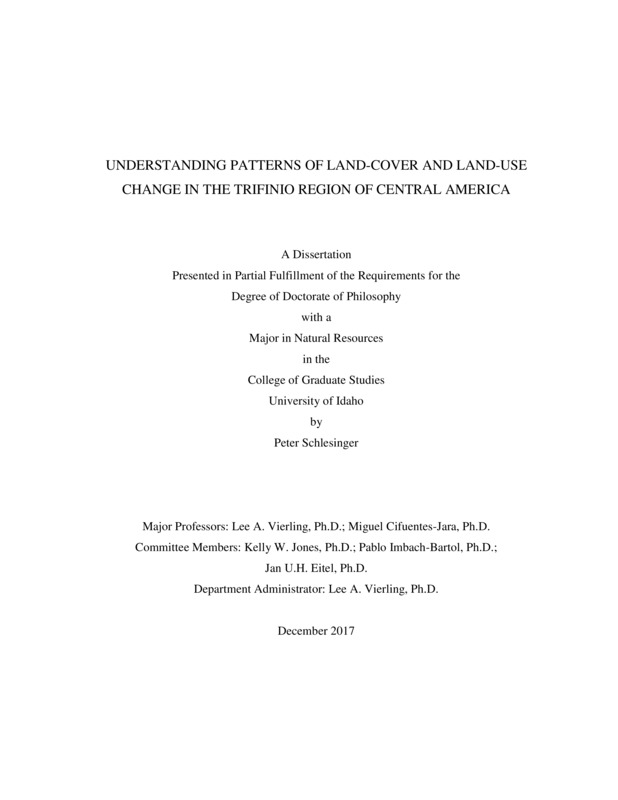UNDERSTANDING PATTERNS OF LAND-COVER AND LAND-USE CHANGE IN THE TRIFINIO REGION OF CENTRAL AMERICA
Schlesinger, Peter. (2017-12). UNDERSTANDING PATTERNS OF LAND-COVER AND LAND-USE CHANGE IN THE TRIFINIO REGION OF CENTRAL AMERICA. Theses and Dissertations Collection, University of Idaho Library Digital Collections. https://www.lib.uidaho.edu/digital/etd/items/schlesinger_idaho_0089e_11283.html
- Title:
- UNDERSTANDING PATTERNS OF LAND-COVER AND LAND-USE CHANGE IN THE TRIFINIO REGION OF CENTRAL AMERICA
- Author:
- Schlesinger, Peter
- ORCID:
- 0000-0002-4861-5202
- Date:
- 2017-12
- Keywords:
- coffee deforestation land use protected area remote sensing Trifinio
- Program:
- Natural Resources
- Subject Category:
- Environmental science; Remote sensing; Latin American studies
- Abstract:
-
Land-cover and land-use studies in Asia, Australia, and Canada began in the early 1970s with the advent of the first Landsat sensors. However, the satellite receiving stations didn’t have extensive coverage until the mid-1980s. With the advent of the new century, regional onsite researchers began noting forest regrowth signs in Central America. However, few investigations took place in the Trifinio Region, a transboundary region at the join of El Salvador, Guatemala and Honduras. Most were considerably beyond, in the Yucatan, the Guatemalan highland, central El Salvador, and the Peten.
In Chapter 1, we examined secondary maps to understand the region, its human and natural resources and changes. We sought to create new modeling, aided by data from participating agricultural development partners. We considered land use data to learn about correlated change drivers and potential transition causes and studied transitions inside and outside the region’s most diverse protected cloud forest park. We found population density correlated with severe deforestation, found a relation between transport and deforestation, and found potential drivers of deforestation to be much the same as those affecting the wider region in Central America and tropical zones.
A bold assumption also underpinning Chapter 2 was that we ought to be able to sense, measure, and compare common results in terms of vegetative responses and differences across the region’s countries, counties, and protected areas. We developed large databases, sampling the territories of the protected and non-protected landscapes of Trifinio Region to explore forest transitions that we could not measure using classical remote sensing classification methods. We prepared percent greenness from NDVI and created novel methods to describe and understand temporal transitions both inside and about 20km outside of the Trifinio Region because there were no tools ready for us to use our short time series data readily, though we found existing gene expression tools useful. We hunted for a sign of forest regrowth or resurgence connected with the regional protected areas, agriculture, pastoral activity, and agroforestry, to corroborate reports from regional studies in the past two decades. In follow-on work in Chapter 3, we calculated pattern and texture measures for an area of central Trifinio Region using different types of relatively new satellite sensors (both optical and radar) with a view to being able to identify differences in shade agroforestry from native forest cover. We found relationships between the two of these measures, shade coffee production, and forest cover. We extracted training sites using a high-resolution sensor to classify these areas using machine learning classifiers; we compared our efforts accuracy estimates with those of other researchers, some of whom had tried some of these classifiers before us. Few experiences have been reported studying rural agriculture with these sensors and techniques.
- Description:
- doctoral, Ph.D., Natural Resources -- University of Idaho - College of Graduate Studies, 2017-12
- Major Professor:
- Vierling, Lee A; Cifuentes-Jara, Miguel
- Committee:
- Jones, Kelly W.; Eitel, Jan U.H.; Imbach-Bartol, Pablo; Vierling, Lee A.; Cifuentes-Jara, Miguel
- Defense Date:
- 2017-12
- Identifier:
- Schlesinger_idaho_0089E_11283
- Type:
- Text
- Format Original:
- Format:
- application/pdf
- Rights:
- In Copyright - Educational Use Permitted. For more information, please contact University of Idaho Library Special Collections and Archives Department at libspec@uidaho.edu.
- Standardized Rights:
- http://rightsstatements.org/vocab/InC-EDU/1.0/

